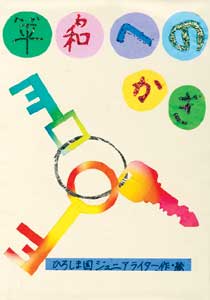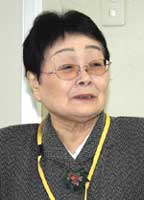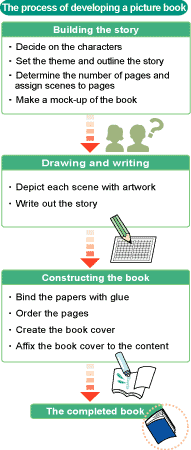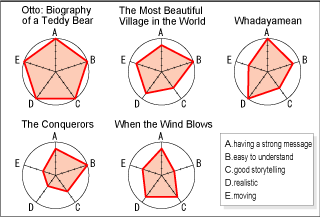The power of picture books
Pages convey messages of peace
For this issue, the junior writers created a picture book called "The Keys to Peace." The main character of the story sets out to learn about the state of the world today and searches for "keys" to make the world a more peaceful place.
To create this book, we first looked back at previous issues of Peace Seeds and the topics we explored. Although we have never personally experienced scenes of war or conflict, we tried to imagine the environments that children of other countries live in and we drew pictures of such scenes. And, while developing the story, we pondered again "What is peace?" We hope you will join us in contemplating this question as you read our book.

"The Keys to Peace" by the Junior Writers of Peace Seeds
The main character is a boy who lives in Japan. He believes the world is at peace because his own life is not threatened by war or conflict. One day he abruptly encounters an old woman and she asks him, "Is our world really at peace?" And she takes him to places in the world that are not at peace.
The boy is shocked when he sees children his own age working, fighting, and carrying guns. It's a world he didn't know. He also observes children being bullied and realizes that violence is happening closer to home, too.
Each time he witnesses a scene that lacks peace, he thinks "How can this situation change?" And he wishes "a key to make peace2 could be found. Finally, he discovers these "keys" are all around him in the form of such actions as "understanding the need," "thinking how to help" and "doing what we can." (Shotaro Takata, 13)
Click the pictures below to enlarge each page of the book.

1
2
3
4
5
6
7
8
9
10
11
12
13
14
15
Click to hear a reading of the story.
A book to express our hopes and stir readers' thoughts
We decided to create a picture book to encourage people to think more about peace. And we included questions in the book so readers would ponder these important issues along with us. We believe it's necessary to face problems both near and far--like "bullying" and "child soldiers"--and work to resolve them. We hope the book will inspire you to imagine how you might feel if you were in such a situation of suffering.
In the process of developing this book, we had the helpful opportunity to think again about such questions as "What is peace?" and "Why is peace important?" We hope we have managed to convey the messages of learning more about the world and thinking what we can do to contribute to a more peaceful world.
The following notes will explain our intentions for these pages.
<2>Child soldiers may behave violently, but they themselves suffer mentally and physically. With more than 250,000 child soldiers in the world, this would amount to 6250 classes of schoolrooms seating 40 students.
<4>This image depicts the starvation of our world. In Japan, we throw away so much leftover food, but we should remember all the people who don't have enough to eat.
<6>We imagined the destruction of the environment, stressing that such a state is connected to our daily life, and our future, due to the impact of cars and factories.
<8>Through a scene involving child labor, we wanted to convey the fact that many children in the world must work and cannot attend school.
<10>Bullying is a problem in Japan, and we have witnessed it personally, so this was an emotional scene for us to draw.
<12>We hope you can feel our sincere hope that the world will never repeat the sort of tragedy that occurred when Hiroshima, our hometown, suffered the atomic bombing.
(Reika Konno, 13, and Aya Tsuchie, 15)
 Interview with Seiko Miura, researcher of children's books
Interview with Seiko Miura, researcher of children's books
Books convey messages of peace to the world

Seiko Miura, researcher of children's books (photo by Masashi Muro, 15)
We interviewed Seiko Miura, 71, a researcher of children's books, who has read about 2000 of the world's children's books on the theme of war and peace. Ms. Miura is the Hiroshima representative of the Japanese Association of Writers for Children and she told us about the power of children's books.
She believes that picture books can convey the truth of war to children through the vision of writers and artists. One of the significant features of children's books is that the artwork can stimulate the imagination of readers and provide the opportunity to ponder a book's theme.
For the best children's book based on the atomic bombing, Ms. Miura recommends "Burned Potatoes" by Tadayoshi Irino. Although the book powerfully depicts the cruelty of the bombing and the suffering of human beings, the artwork does not include bloody scenes and so children are not frightened to read it.
As for books produced abroad, she suggests such titles as Erich Kastner's "The Animal's Conference," which relates the foolishness of human beings as they engage in wars while speaking in animal tongues; Eleanor Coerr's book about Sadako Sasaki called "Sadako"; and "Otto: Biography of a Teddy Bear" by Tomi Ungerer, a French author.
Ms. Miura commented, "Until the 1980s, only the reality of war was expressed in most children's books on this subject, but lately the authors' feelings are also being conveyed. In books from all over the world, we can feel the wish for peace that writers and artists hope to share through their work." (Kanchika Ryu, 18)
Developing a picture book

Junior writers work on their picture book. (photo by Ryu Kanchika,18)
Ms. Miura taught us how to create a picture book at a two-day workshop.

First, we developed the story around the theme "gthe importance of peace." She advised us to imagine a story that wouldn't frighten small children and would be easy for them to understand. We came up with many ideas, but it was hard to put them together into a single story.
We then created a total of 26 pictures, dividing the work among the six members of our group.
Ms. Miura suggested we make our pictures by piecing together bits of colored paper, rather than using simple drawings. She told us, "Expressing yourselves freely is more important than trying to create perfect pictures." And for the last page, we made a "pop up" image.
It was the first time we tried making pictures with a collage of colored paper so it was difficult for us. But we gradually made good progress and we enjoyed the new challenge. Another positive point of creating the artwork is the fact that we had more time to ponder the themes of our story than if we had simply written the story without first making pictures.
Binding the book together was hard, too, but Ms. Miura was a great help to us. The last step of our project was adding the cover, an important task in which the content of the book is expressed in a single image. (Masashi Muro,15)
Click to view the workshop.
5 "peace books" to recommend
We selected five books on the theme of peace that we would like to recommend. We gave each book marks in five areas: "having a strong message," "easy to understand," "good storytelling," "realistic," and "moving." These books are listed in order of their scores. (Aya Nakashige, 18)

"Otto: Biography of a Teddy Bear" by Tomi Ungerer
Otto is a teddy bear who was owned by a Jewish boy during World War II. The story is told through the eyes of Otto, looking back on his life, and the themes of "the persecution of the Jewish people" and "the cruelty of war" are expressed in a simple style that is easy to read.
The pictures in the book help the reader clearly understand Otto's feelings. The scenes of war were particularly shocking. This book conveys the powerful message that ethnic intolerance must be prevented and war must not be waged.
"The Most Beautiful Village in the World" by Yutaka Kobayashi
The story of a village in Afghanistan, disrupted by war. A boy, Yamo, was living peacefully in the village and yet worried about his older brother who was off fighting as a soldier. In a moving scene, the boy names a lamb "Spring" in the hope that his brother will return home when Spring comes.
But, in the end, war dashes the boy's hopes. His peaceful life is destroyed and the reader is saddened by his loss.
"Whadayamean" by John Burningham
God shows two children scenes of the environmental crisis facing our planet. He gives them the mission of protecting the world by preventing adults from continuing their harmful ways.
At first, the adults don't listen to the children, but once they realize that the children's message comes from God, they begin behaving differently and the world becomes a wonderful place.
The book made a strong impression on us. The author puts across his theme directly to children in the form of a message from God. The idea that children are important leaders in changing the world is similar to our own mission with Peace Seeds.
"The Conquerors" by David McKee
One of the appealing parts of this book is the lovely artwork that can attract small children. In the story, the people of a "big country," which is armed with soldiers and weapons, find a happier life through their relationship with a "small country" that has no military power. The president of the "big country" rebukes his soldiers when they are won over by the "small country," but in the end, he sings a song about the "small country" to his son--a touching moment.
"When the Wind Blows" by Raymond Briggs

A British couple, trying to save themselves in the midst of a nuclear war, turn to a manual produced by the government. Despite their optimistic outlook and their belief that the government will rescue them, they die from radiation exposure as they read the Bible.
The pages on which the couple appear consist of about 20 frames, like a comic book. The scenes of warfare and nuclear weapons, on the other hand, are powerful spreads of two full pages. This creates an effective contrast and relationship between the small scale of the couple's life and the large scale of the war.
Although the couple's conversation, at first sight, seems absurd, this dialogue helps to convey the author's theme. An impressive book, but the Japanese version may be difficult for younger children because of the small writing and many kanji characters.
Pages convey messages of peace
For this issue, the junior writers created a picture book called "The Keys to Peace." The main character of the story sets out to learn about the state of the world today and searches for "keys" to make the world a more peaceful place.
To create this book, we first looked back at previous issues of Peace Seeds and the topics we explored. Although we have never personally experienced scenes of war or conflict, we tried to imagine the environments that children of other countries live in and we drew pictures of such scenes. And, while developing the story, we pondered again "What is peace?" We hope you will join us in contemplating this question as you read our book.

"The Keys to Peace" by the Junior Writers of Peace Seeds
The main character is a boy who lives in Japan. He believes the world is at peace because his own life is not threatened by war or conflict. One day he abruptly encounters an old woman and she asks him, "Is our world really at peace?" And she takes him to places in the world that are not at peace.
The boy is shocked when he sees children his own age working, fighting, and carrying guns. It's a world he didn't know. He also observes children being bullied and realizes that violence is happening closer to home, too.
Each time he witnesses a scene that lacks peace, he thinks "How can this situation change?" And he wishes "a key to make peace2 could be found. Finally, he discovers these "keys" are all around him in the form of such actions as "understanding the need," "thinking how to help" and "doing what we can." (Shotaro Takata, 13)
Click the pictures below to enlarge each page of the book. |
||||
 |
1 |
2 |
3 | |
4 |
5 |
6 |
7 | |
8 |
9 |
10 |
11 | |
12 |
13 |
14 |
15 | |
| ||||
A book to express our hopes and stir readers' thoughts
We decided to create a picture book to encourage people to think more about peace. And we included questions in the book so readers would ponder these important issues along with us. We believe it's necessary to face problems both near and far--like "bullying" and "child soldiers"--and work to resolve them. We hope the book will inspire you to imagine how you might feel if you were in such a situation of suffering.
In the process of developing this book, we had the helpful opportunity to think again about such questions as "What is peace?" and "Why is peace important?" We hope we have managed to convey the messages of learning more about the world and thinking what we can do to contribute to a more peaceful world.
The following notes will explain our intentions for these pages.
<2>Child soldiers may behave violently, but they themselves suffer mentally and physically. With more than 250,000 child soldiers in the world, this would amount to 6250 classes of schoolrooms seating 40 students.
<4>This image depicts the starvation of our world. In Japan, we throw away so much leftover food, but we should remember all the people who don't have enough to eat.
<6>We imagined the destruction of the environment, stressing that such a state is connected to our daily life, and our future, due to the impact of cars and factories.
<8>Through a scene involving child labor, we wanted to convey the fact that many children in the world must work and cannot attend school.
<10>Bullying is a problem in Japan, and we have witnessed it personally, so this was an emotional scene for us to draw.
<12>We hope you can feel our sincere hope that the world will never repeat the sort of tragedy that occurred when Hiroshima, our hometown, suffered the atomic bombing.
(Reika Konno, 13, and Aya Tsuchie, 15)
|
Books convey messages of peace to the world
We interviewed Seiko Miura, 71, a researcher of children's books, who has read about 2000 of the world's children's books on the theme of war and peace. Ms. Miura is the Hiroshima representative of the Japanese Association of Writers for Children and she told us about the power of children's books. She believes that picture books can convey the truth of war to children through the vision of writers and artists. One of the significant features of children's books is that the artwork can stimulate the imagination of readers and provide the opportunity to ponder a book's theme. For the best children's book based on the atomic bombing, Ms. Miura recommends "Burned Potatoes" by Tadayoshi Irino. Although the book powerfully depicts the cruelty of the bombing and the suffering of human beings, the artwork does not include bloody scenes and so children are not frightened to read it. As for books produced abroad, she suggests such titles as Erich Kastner's "The Animal's Conference," which relates the foolishness of human beings as they engage in wars while speaking in animal tongues; Eleanor Coerr's book about Sadako Sasaki called "Sadako"; and "Otto: Biography of a Teddy Bear" by Tomi Ungerer, a French author. Ms. Miura commented, "Until the 1980s, only the reality of war was expressed in most children's books on this subject, but lately the authors' feelings are also being conveyed. In books from all over the world, we can feel the wish for peace that writers and artists hope to share through their work." (Kanchika Ryu, 18) | |||
|
Developing a picture book
Ms. Miura taught us how to create a picture book at a two-day workshop. 
First, we developed the story around the theme "gthe importance of peace." She advised us to imagine a story that wouldn't frighten small children and would be easy for them to understand. We came up with many ideas, but it was hard to put them together into a single story. We then created a total of 26 pictures, dividing the work among the six members of our group. Ms. Miura suggested we make our pictures by piecing together bits of colored paper, rather than using simple drawings. She told us, "Expressing yourselves freely is more important than trying to create perfect pictures." And for the last page, we made a "pop up" image. It was the first time we tried making pictures with a collage of colored paper so it was difficult for us. But we gradually made good progress and we enjoyed the new challenge. Another positive point of creating the artwork is the fact that we had more time to ponder the themes of our story than if we had simply written the story without first making pictures. Binding the book together was hard, too, but Ms. Miura was a great help to us. The last step of our project was adding the cover, an important task in which the content of the book is expressed in a single image. (Masashi Muro,15)
|
5 "peace books" to recommend
|
We selected five books on the theme of peace that we would like to recommend. We gave each book marks in five areas: "having a strong message," "easy to understand," "good storytelling," "realistic," and "moving." These books are listed in order of their scores. (Aya Nakashige, 18) 
"Otto: Biography of a Teddy Bear" by Tomi Ungerer Otto is a teddy bear who was owned by a Jewish boy during World War II. The story is told through the eyes of Otto, looking back on his life, and the themes of "the persecution of the Jewish people" and "the cruelty of war" are expressed in a simple style that is easy to read. The pictures in the book help the reader clearly understand Otto's feelings. The scenes of war were particularly shocking. This book conveys the powerful message that ethnic intolerance must be prevented and war must not be waged. "The Most Beautiful Village in the World" by Yutaka Kobayashi The story of a village in Afghanistan, disrupted by war. A boy, Yamo, was living peacefully in the village and yet worried about his older brother who was off fighting as a soldier. In a moving scene, the boy names a lamb "Spring" in the hope that his brother will return home when Spring comes. But, in the end, war dashes the boy's hopes. His peaceful life is destroyed and the reader is saddened by his loss. "Whadayamean" by John Burningham God shows two children scenes of the environmental crisis facing our planet. He gives them the mission of protecting the world by preventing adults from continuing their harmful ways. At first, the adults don't listen to the children, but once they realize that the children's message comes from God, they begin behaving differently and the world becomes a wonderful place. The book made a strong impression on us. The author puts across his theme directly to children in the form of a message from God. The idea that children are important leaders in changing the world is similar to our own mission with Peace Seeds. "The Conquerors" by David McKee One of the appealing parts of this book is the lovely artwork that can attract small children. In the story, the people of a "big country," which is armed with soldiers and weapons, find a happier life through their relationship with a "small country" that has no military power. The president of the "big country" rebukes his soldiers when they are won over by the "small country," but in the end, he sings a song about the "small country" to his son--a touching moment. "When the Wind Blows" by Raymond Briggs 
A British couple, trying to save themselves in the midst of a nuclear war, turn to a manual produced by the government. Despite their optimistic outlook and their belief that the government will rescue them, they die from radiation exposure as they read the Bible. The pages on which the couple appear consist of about 20 frames, like a comic book. The scenes of warfare and nuclear weapons, on the other hand, are powerful spreads of two full pages. This creates an effective contrast and relationship between the small scale of the couple's life and the large scale of the war. Although the couple's conversation, at first sight, seems absurd, this dialogue helps to convey the author's theme. An impressive book, but the Japanese version may be difficult for younger children because of the small writing and many kanji characters. |